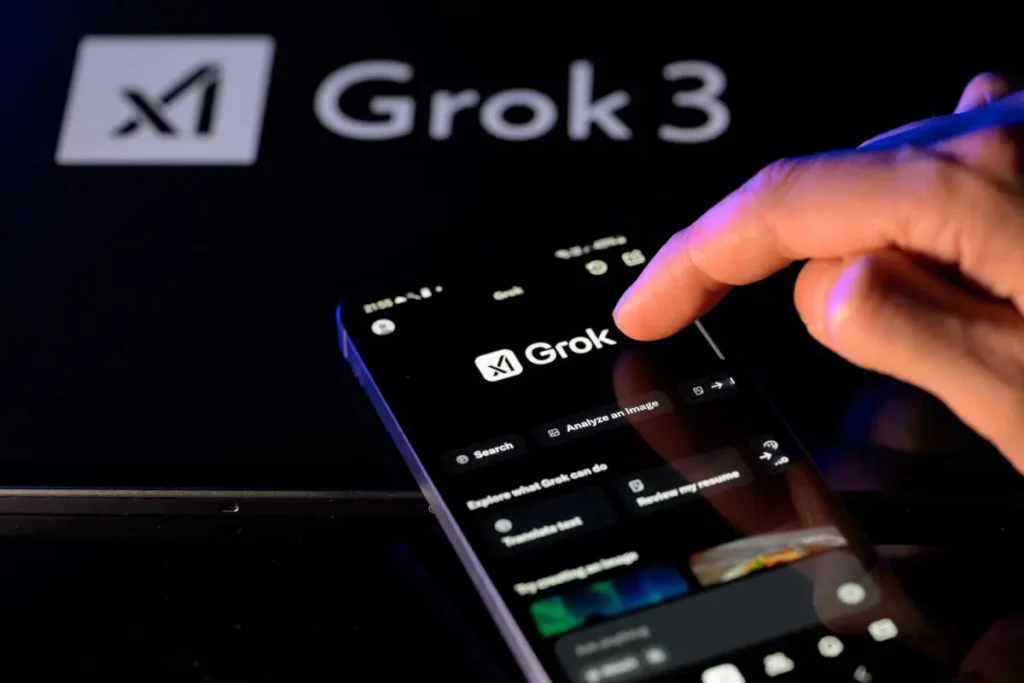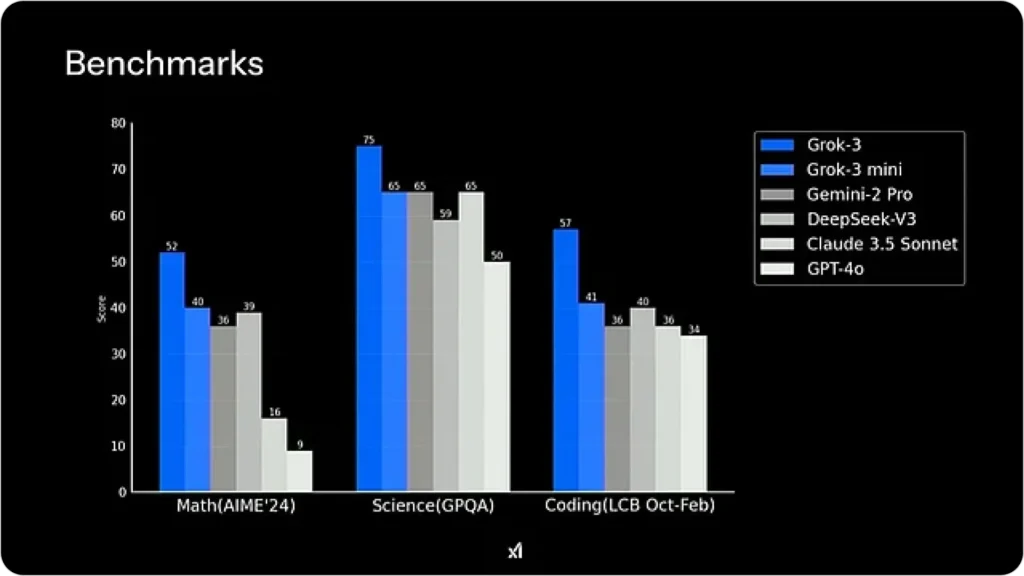Grok 3 vs GPT-4o: Which AI Model Leads the Way?
The artificial intelligence (AI) landscape is rapidly evolving, with leading tech companies unveiling advanced models that push the boundaries of machine learning and natural language processing. Two prominent contenders in this arena are xAI’s Grok 3 and OpenAI’s GPT-4o. Both models have garnered significant attention for their capabilities and potential applications. This article provides an in-depth comparison of Grok 3 and GPT-4o, examining their features, performance, and suitability for various tasks.

What is Grok 3?
Developed by Elon Musk’s xAI, Grok 3 represents a significant advancement in AI technology. According to xAI, Grok 3 boasts over ten times the computing power of its predecessor, enabling it to handle complex tasks with enhanced efficiency. The model introduces two distinct reasoning modes:
- Think Mode: Displays Grok’s reasoning process as it addresses requests, providing transparency into its problem-solving approach.
- Big Brain Mode: Designed for more complex tasks requiring substantial computational resources, aiming to deliver more accurate and nuanced responses.
Additionally, Grok 3 incorporates “Deep Search,” an AI search engine that scans the internet and the social media platform X (formerly Twitter) to provide detailed answers to user queries. This feature enhances the model’s ability to retrieve and synthesize real-time information.
What is GPT-4o?
OpenAI‘s GPT-4o is the latest iteration in the Generative Pre-trained Transformer series. Released in November 2024, GPT-4o features a context window of 128,000 tokens and supports generating up to 16,384 tokens per request. The model is designed to excel in a wide range of applications, from creative writing to business insights and programming. Notably, GPT-4o offers multimodal capabilities, allowing it to process text, images, and audio seamlessly. This versatility makes it a valuable tool for content creators and professionals seeking an AI assistant with broad applicability.
OpenAI’s GPT-4o has recently undergone significant updates, notably enhancing its image generation capabilities. In late March 2025, OpenAI introduced a feature that allows users to create images directly within ChatGPT, powered by the GPT-4o model. This update has led to a surge in popularity, particularly for generating Studio Ghibli-style images, resulting in record-breaking user engagement.
Related topics The Latest GPT-4o Image Creation: What can you do
How Do Grok-3 and GPT-4o Perform in Benchmark Tests?

Computational Power and Efficiency
Grok 3’s substantial increase in computing power is a key differentiator. This enhancement enables the model to perform complex calculations and process large datasets more efficiently than its predecessors. In contrast, GPT-4o, while powerful, operates with a smaller context window and may require more computational resources to handle similarly complex tasks.
Reasoning and Problem-Solving Abilities
Grok 3 introduces advanced reasoning capabilities through its Think and Big Brain modes. These features allow the model to break down complex tasks and self-verify its outputs, aiming for higher accuracy in responses. GPT-4o, on the other hand, is renowned for its strong natural language understanding and generation, making it adept at producing coherent and contextually relevant text across various subjects.
Multimodal Capabilities
GPT-4o’s ability to process text, images, and audio gives it a significant edge in applications requiring multimodal integration. This feature is particularly beneficial for content creation, allowing users to generate diverse forms of media seamlessly. Grok 3, while primarily focused on text-based processing, offers “Deep Search,” enhancing its ability to retrieve and synthesize real-time web information.
What Are the Practical Applications of Each Model?
Grok 3: Ideal Use Cases
Grok 3’s emphasis on computational power and advanced reasoning makes it particularly suited for tasks in mathematics, science, and coding. Professionals in these fields may find Grok 3 valuable for complex problem-solving and data analysis. Additionally, its “Deep Search” capability allows for real-time information retrieval, beneficial for research and development purposes.
GPT-4o Pricing:
API Usage: OpenAI charges for GPT-4o API access based on token usage:
- Input Tokens: $5.00 per million tokens.
- Output Tokens: $15.00 per million tokens.
ChatGPT Access:
- ChatGPT Plus: $20 per month, providing access to GPT-4o along with other features.
- ChatGPT Pro: $200 per month, offering enhanced capabilities and higher usage limits.
GPT-4o: Ideal Use Cases
GPT-4o’s versatility and multimodal capabilities make it an excellent choice for content creators, marketers, and customer service applications. Its ability to generate human-like text, process images, and understand audio inputs allows for a wide range of creative and professional applications. Furthermore, GPT-4o’s strong natural language understanding makes it suitable for conversational AI systems and virtual assistants.
The costs for accessing GPT-4o and Grok 3 vary based on usage and subscription plans:
Grok 3 Pricing:
- X Premium+ Subscription: $40 per month, includes access to all four Grok 3 models:
- Grok 3
- Grok 3 Mini
- Grok 3 Reasoning
- Grok 3 Mini Reasoning
- SuperGrok Plan: Designed for power users and businesses, this plan is priced at $30 per month or $300 annually. It offers advanced features such as DeepSearch and enhanced reasoning modes.
These pricing structures are subject to change, so it’s advisable to consult the official OpenAI and xAI websites for the most current information.
How Do Subscription Models and Accessibility Compare?
Grok 3 is available to X Premium Plus subscribers, with recent reports indicating an increase in subscription costs. This pricing model may influence accessibility for individual users and small businesses. In contrast, GPT-4o is accessible through OpenAI’s API, with usage-based pricing that may offer more flexibility for users with varying needs and budgets.
Use GPT 4o API and Grok 3 API in CometAPI
CometAPI offer a price far lower than the official price to help you integrate GPT-4o API(model name: gpt-4o-all;gpt-4o-image) and Grok 3 API (model name: grok-3; grok-3-reasoner; grok-3-deepsearch), and you will get $1 in your account after registering and logging in! Welcome to register and experience CometAPI.
CometAPI acts as a centralized hub for APIs of several leading AI models, eliminating the need to engage with multiple API providers separately.
Please refer to GPT-4o API and Grok 3 API for integration details.
Pricing in CometAPI is structured as follows:
| Category | GPT-4o | Grok 3 |
| API Pricing | Input Tokens: $2/ M tokens Output Tokens: $8 / M tokens | Input Tokens: $1.6 / M tokens Output Tokens: $6.4 / M tokens |
Conclusion
Both Grok 3 and GPT-4o represent significant advancements in AI technology, each with unique strengths and applications. Grok 3’s enhanced computational power and advanced reasoning modes make it a formidable tool for technical professionals requiring robust problem-solving capabilities. Conversely, GPT-4o’s multimodal integration and natural language prowess position it as a versatile AI assistant suitable for a broad spectrum of creative and professional tasks. The choice between Grok 3 and GPT-4o ultimately depends on specific user requirements, including the nature of tasks, desired features, and budget considerations.
